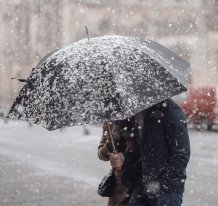articles

Lead author of the study, Dr Richard Hall, said there was an increased chance of extreme cold, and potentially snow, over the next week or two.
Ongoing sudden stratospheric warming could increase risk of snow over coming weeks
A pioneering new study helps shed light on the chances of extreme cold, and potentially snow in the UK in the next fortnight.
A dramatic meteorological event, known as a sudden stratospheric warming (SSW), is currently unfolding high over the Arctic. SSW events are some of the most extreme of atmospheric phenomena, occurring in only about 6 of every 10 winters, and see polar stratospheric temperature increase by up to 50°C over the course of a few days.
The usual strong westerly winds of the stratospheric polar vortex also break down and reverse in direction.
The new study, by experts from the universities of Exeter, Bristol and Bath, involved the analysis of 40 observed SSW events which occurred over the last 60 years. Researchers developed a novel method for tracking the signal of an SSW downward from its onset in the stratosphere to the surface.
These events are linked to severe weather events, such as the infamous 2018 “Beast from the East” which covered the UK in swathes of snow.
The study is published in the Journal of Geophysical Research and funded by the Natural Environment Research Council (NERC).
The stratosphere is the layer of the atmosphere from around 10-50km above the earth’s surface.
The disturbance in the stratosphere can be transmitted downward and if this continues to the earth’s surface, there can be a shift in the jet stream, leading to unusually cold weather across Europe and Northern Asia. It can take a number of weeks for the signal to reach the surface, or the process may only take a few days.
Findings in the paper,Tracking the stratosphere‐to‐surface impact of Sudden Stratospheric Warmings suggest split events tend to be associated with colder weather over north west Europe and Siberia.
Dr William Seviour, senior lecturer at the Department of Mathematics and Global Systems Institute, University of Exeter, and co-author of the study said: “Our study helps to quantify the probabilities of when we might expect extreme surface weather following a sudden stratospheric warming (SSW) event.
“These vary widely, but importantly the impacts appear faster and stronger following events in which the stratospheric polar vortex splits in two, as may possibly occur in currently unfolding event.
“Despite this advance many questions remain as to the mechanisms causing these dramatic events, and how they can influence the surface, and so this is an exciting and important area for future research.”
Lead author of the study, Dr Richard Hall, said there was an increased chance of extreme cold, and potentially snow, over the next week or two.
“While an extreme cold weather event is not a certainty, around two thirds of SSWs have a significant impact on surface weather. At the moment it is hard to say whether this event is going to be a split or displacement type.”
“The extreme cold weather that these polar vortex breakdowns bring is a stark reminder of how suddenly our weather can flip. Even with climate change warming our planet, these events will still occur, meaning we must be adaptable to an ever more extreme range of temperatures,” said Dann Mitchell, Associate Professor of Atmospheric Science at the University of Bristol and co-author of the study.
Date: 6 January 2021